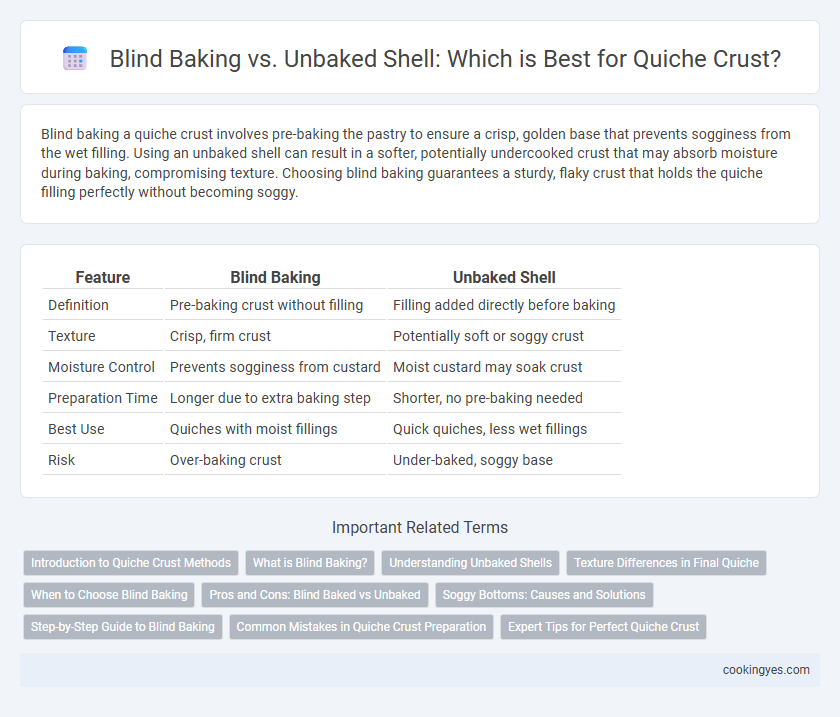Blind baking a quiche crust involves pre-baking the pastry to ensure a crisp, golden base that prevents sogginess from the wet filling. Using an unbaked shell can result in a softer, potentially undercooked crust that may absorb moisture during baking, compromising texture. Choosing blind baking guarantees a sturdy, flaky crust that holds the quiche filling perfectly without becoming soggy.
Table of Comparison
| Feature | Blind Baking | Unbaked Shell |
|---|---|---|
| Definition | Pre-baking crust without filling | Filling added directly before baking |
| Texture | Crisp, firm crust | Potentially soft or soggy crust |
| Moisture Control | Prevents sogginess from custard | Moist custard may soak crust |
| Preparation Time | Longer due to extra baking step | Shorter, no pre-baking needed |
| Best Use | Quiches with moist fillings | Quick quiches, less wet fillings |
| Risk | Over-baking crust | Under-baked, soggy base |
Introduction to Quiche Crust Methods
Blind baking a quiche crust involves pre-cooking the pastry to ensure a crisp, golden base that prevents sogginess from the custard filling. Using an unbaked shell allows the crust to bake simultaneously with the quiche filling, resulting in a softer, more tender texture. Choosing between blind baking and an unbaked shell depends on desired crust firmness and recipe specifics.
What is Blind Baking?
Blind baking is the process of pre-baking a quiche crust before adding the filling, ensuring a crisp and fully cooked base. It involves lining the crust with parchment paper and filling it with pie weights or dried beans to prevent bubbling and shrinking. This technique is essential for custard-based quiches to avoid a soggy bottom and maintain structural integrity during baking.
Understanding Unbaked Shells
Unbaked quiche crusts retain a tender, flaky texture by absorbing moisture from the filling during baking, preventing sogginess when properly prepared. Choosing an unbaked shell requires careful selection of high-fat butter or shortening dough to ensure structural integrity without pre-baking. This method simplifies preparation but demands precise filling consistency and oven temperature to avoid undercooked or soggy crusts.
Texture Differences in Final Quiche
Blind baking a quiche crust ensures a crisp, firm texture that prevents sogginess from the quiche filling, maintaining structural integrity. An unbaked shell absorbs more moisture during baking, resulting in a softer, sometimes mushy crust that lacks the desired crunch. Texture contrast between a crisp blind-baked crust and a tender unbaked one significantly impacts the overall mouthfeel and eating experience of the quiche.
When to Choose Blind Baking
Blind baking is essential for quiche crusts with wet fillings or custards to prevent sogginess and ensure a crisp, golden base. Choose blind baking when using high-moisture ingredients like vegetables or cheese that release water during cooking. This technique enhances texture by pre-cooking the crust, avoiding a soggy bottom and maintaining structural integrity during baking.
Pros and Cons: Blind Baked vs Unbaked
Blind baking a quiche crust ensures a crisp, fully cooked base that prevents sogginess from the custard filling and maintains structural integrity during baking. However, it requires additional prep time and careful monitoring to avoid over-browning or shrinkage. An unbaked shell simplifies the process and allows the crust to absorb some filling flavors, but it risks a soggy, undercooked bottom that compromises texture and firmness.
Soggy Bottoms: Causes and Solutions
Soggy bottoms in quiche crust often result from insufficient moisture barriers or underbaking, making blind baking essential to create a firm, golden shell. Using techniques like pricking the dough with a fork, lining the crust with parchment paper, and filling it with pie weights during blind baking prevents puffing and ensures even cooking. Avoiding a soggy crust also involves thoroughly draining wet fillings and baking the quiche long enough for the custard to set, preserving a crisp, flaky texture.
Step-by-Step Guide to Blind Baking
To blind bake a quiche crust, first prick the dough with a fork to prevent air bubbles, then line it with parchment paper and fill with pie weights or dried beans to keep the shape intact. Bake at 375degF (190degC) for 15 minutes, remove the weights and parchment, then bake for an additional 5-7 minutes until the crust is golden and set. This method ensures a crisp, firm base that prevents sogginess when adding the custard filling.
Common Mistakes in Quiche Crust Preparation
Blind baking a quiche crust prevents sogginess by pre-cooking the pastry, while an unbaked shell risks a undercooked, doughy base. Common mistakes include skipping the docking process or omitting weights during blind baking, causing uneven puffing and air bubbles. Using cold fillings on a blind-baked crust can also affect texture, leading to a less crisp result.
Expert Tips for Perfect Quiche Crust
Blind baking quiche crust ensures a crisp, golden base by pre-baking the dough with pie weights to prevent puffing and shrinkage. Using parchment paper or aluminum foil during blind baking protects the crust and promotes even cooking, while docking the dough can also reduce bubbles. For unbaked shells, carefully layering cold ingredients and baking at a moderate temperature prevents sogginess and maintains a tender, flaky texture, crucial for an expertly crafted quiche crust.
Blind Baking vs Unbaked Shell for Quiche Crust Infographic

 cookingyes.com
cookingyes.com